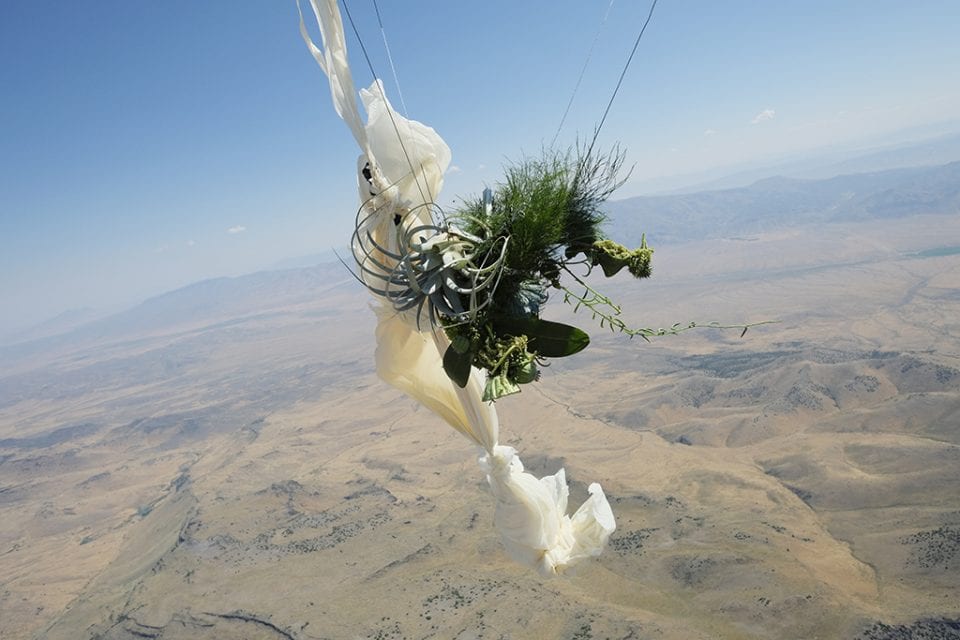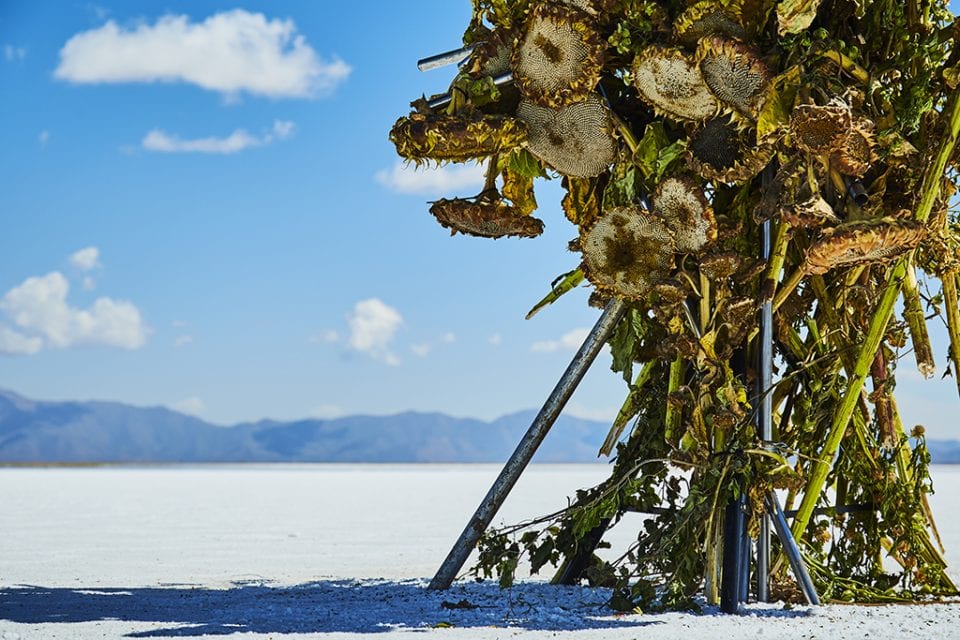Humanity’s interaction with nature is being redefined. Makoto Azuma highlights this, juxtaposing ancient tradition with innovative technologies.
On 21 June 2016, Makoto Azuma (b. 1976) set 2000 flowers on fire at the Oya Stone Mine in Tochigi, Japan. Burning Flowers incorporated the incineration of gymea lilies, dahlias, gloriosas, cockscombs, gerberas, heliconias, proteas, roses and more. The piece used mostly red blooms; the colours of the petals intertwined with the reds and oranges of the flames that consumed them. It was one of the artist’s most dramatic projects to date, but it was also typical of his style. Azuma creates fantastical, mind-bending installations that connect to the beauty of the natural world whilst drawing attention to differing levels of manmade intervention.
Azuma tests the limits of sculpture and installation. He has sent flower arrangements into space (In Bloom #1: Exobiotanica 1 – Botanical Space Flight, Nevada, 2014) and dropped them to the bottom of the ocean (In Bloom #3: Sephirothic Flower, Suruga Bay, 2017). He has frozen plants in blocks of ice (Iced Flowers, Saitama, 2015) and laid them out by the thousand to wither and die. He has sent flowers drifting out to sea and arranged them in artisan vases (In Bloom #2: DAGAT & BULAKLAK, Negros Island, 2015). His practice is spectacular, unusual – and very particular – so it’s surprising to find out it all started off by accident.
Born in Fukuoka Prefecture, Azuma’s first passion was music; in 1997, he moved to Tokyo with the hope of pursuing a career in the industry. Whilst waiting for this to take off, he took a part-time job in a flower shop, and discovered an unknown love of botany. It seemed an unlikely sidestep, but for Azuma, it felt like a natural career move because music and plants – he suggests – have much in common. “Both are ephemeral, momentary and unique. Just as there are as many kinds of red roses, a piece of music is always different depending on the mental state of the musician and the environment in which they are playing.”
By 1999, he was managing a boutique flower shop in Tokyo’s central Azabu-Juban district. In 2002, he opened up his first personal venture: Jardin des Fleurs – a collaboration with the photographer Shiinoki Shunsuketo – which was based first in the upscale Ginza, and now in the fashionable Minami Aoyama district. Azuma thinks of the project in terms of a “laboratory.” In the space, he carefully controls the light, humidity and temperature – as well as the volume of the music inside it – to create the optimal environment. In his ethereal “garden,” he has worked with many high-profile brands such as Dries Van Noten, Hermès and Boucheron. Evidently, this is no ordinary flower shop.
Being an artist and being a florist are viewed as “equal” to Azuma, but he adds that work at Jardin des Fleurs involves a triangular balance between “creativity, customer requests and material.” Gradually, he felt compelled to embark on personal creative endeavours, sparking an intimate dialogue with plants. In 2005, he started producing installations that display and manipulate botany in cutting-edge ways.
Early series include Shiki, which included suspending Bonsai Trees in stark isolation. In 2007, he created Mominoki Moeru (Burning Fir), in which he set a tree on fire. In 2008, he founded AMPG (Azuma Makoto Private Gallery) in order to further experiment with new ideas – working out of an old print shop in Tokyo. Azuma made and exhibited one work a month at AMPG from April 2007 to March 2009, before launching Azuma Makoto Kaju Kenkyujo. AMPG proved pivotal, laying the foundations of his practice and fostering a spirit of invention. “All my works are experimental. Sometimes I end up using radical methods; sometimes they are incredibly common.” For the artist, there are no particular “rules” for successful creative expression, but the intention must be exact: to always respect life and spark a conversation with it directly. “I believe that as long as you have that kind of soul, the flower will answer in return.”
These kinds of conversations have involved using the latest technology such as freezing plants by soaking them in liquid nitrogen. Using this approach In Block Flowers (Tokyo, 2016), for example, he isolated stems he had picked or grown and fixed them within a particular moment in time. He has also built displays with obvious, and even exaggerated, human intervention. In Fighting Flowers (Shanghai, 2017), Azuma installed plants in a wire mesh cube measuring 2.5 metres high, evoking concepts of imprisonment by using a material usually implemented to make fences. The installation was overwhelming.
At other times, his work is stripped-back and gestural: simply laying flowers down to dry out and decompose, or handing them out, for free, to passers-by. Azuma says that technology doesn’t matter – the point is always to find new ways to showcase organic beauty and to encourage people to appreciate and therefore respect the natural world. In June 2013, he travelled to Belém, near the mouth of the Amazon, to find out more about the plants and flowers there, many of which have yet to be discovered and documented. Sadly, some of these unknown flora will disappear without ever being known as their habitat comes under increasing threat from manmade industries such as logging and mining. In 2018, he paid tribute to these mysterious other lifeforms with an 80kg hanging sculpture, constructed at a former school In São Paulo.
Here, Azuma also references much older Japanese traditions, looking back to the ancient art of flower-arranging, which was popularised in the 16th century but dates back to the 7th century. The occupation draws on Buddhist ideas, and even earlier philosophies. The idea of “listening” to the natural world is part of the Ikebana tradition in which gods or spirits inhabit all things. “I have never been aware of it directly, but I am born and bred Japanese, so I believe this way of thinking is deeply ingrained. Japanese people liken trees to gods and venerate [some] as sacred trees called Goshinboku. They believe that deities exist everywhere, so they approach nature with a feeling of awe and reverence. Without respect for nature, the process of changing life into artwork does not happen. I think that sense of tension adds even more power to my work.”
Azuma emphasises all stages of life cycles, including decay, and shows a keen awareness of the fact that the plants will die, adding a further layer of performativity to each piece. He instils the concept of “Mono-no aware”: a wistful appreciation of life that’s made bittersweet by the fact that all beings must eventually pass away. First conceptualised in Japanese literature 1000 years ago, this concept underlines the tradition of gathering to admire ephemeral cherry blossoms (lasting only a week). The acceptance of transience and death also underpins a slightly grislier Buddhist tradition known as “Kusozu”: paintings of corpses which depict the process of decomposition.
Fragility is central to Azuma; his work is always destined to wither and die in the end. “The life cycle of a flower is so short, which is why the very lifetime of a flower is even more precious and heavier than a those of a human being.” He evokes the precarious situation of the planet, as we hang in the universe, 100 seconds to midnight as registered on the Doomsday Clock. In Bloom #1: Exobiotanica 1 – Botanical Space Flight, for example, shows the Earth floating in space just behind the arrangement. Whilst we’re facing Covid-19 and the climate crisis, this perspective is crucial.
Even though these artworks will eventually fade, fall apart or simply disappear, photographs will document their single-use existence – images which remain “durable and fixed,” as Henry Fox Talbot posited in The Pencil of Nature back in 1846. Azuma’s works are always shot by the same photographer – his business partner Shiinoki Shunsuke – who, rather than just documenting the plants and flowers in these otherworldly environments, takes shots that emulate Azuma’s complex approach. “I always try to capture the moment of flowers acutely,” explains Shunsuke. “To achieve this, I use various angles, lighting and methods of shooting to express beauty and mystery.”
Azuma’s art can be interpreted not just in terms of Japanese culture, but also in light of wider human impulses such as the urge to cultivate and harness the wilderness, which is inevitably juxtaposed with the yearning to be out, appreciating the beauty of forests, oceans and parks. Never has such a point been amplified, with the lockdown forcing humans to be inside their homes and allowing – if the memes are to be believed – nature to flourish and rebloom. Afterall, if people want to look at flowers they only have to go outside. And, for as long we can remember, flowers have been used to mark important rites of passage: births, weddings and funerals. It’s an impulse that the artist has directly explored, with the 2016 installation Burning Flowers dedicated to his friend and theatre director Yukio Ninagawa, who died the month before. Ninagawa had also asked Azuma to provide the flowers for his hospital room, and later to take responsibility for tributes at the funeral.
In June 2018, Azuma produced Botanical Sculpture: Prayer for Fukushima, a sculpture installed in a high school in remembrance of those who lost their lives in the nuclear disaster; his ongoing artworks Flowers for Peace in Hiroshima and Nagasaki involve leaving flowers at memorials to those who died in the atomic bombing of these cities. “Flowers accompany human life. In Japan, we can find fossils of flowers in ancient Jomon period tombs [which date back 10,000 years]. People back then treated plants as something holy – that is not something that can be explained by reason, it’s more like a feeling hidden in us.”
This is an ancient instinct, but it’s also increasingly necessary to life in the 21st century. Our daily lives – and the media – are dominated by the Covid-19 virus, but in the background, slower, yet perhaps more lethal, issues continue. Mass consumption, deforestation, plastic manufacturing and toxic emissions are still burning through our resources, pushing us closer to global species extinction. Right now, we need art that makes us think about what we value the most. “As times have changed, the needs of flora and fauna have increased and broadened. And I can foresee that these needs will become even stronger.”
Kate Simpson
Flower Art is published by Thames & Hudson
thamesandhudson.com | azumamakoto.com
-

Azuma Makoto, In Bloom #4: EXOBIOTANICA II — Botanical Space Flight, in Nevada, 2017. Photograph by Shiinoki Shunsuke/ Courtesy of AMK. -

Azuma Makoto, Sequia y Sombra, in Argentina, 2018. Photograph by Shiinoki Shunsuke/ Courtesy of AMKK -

Azuma Makoto, Botanical Sculpture: Sequía y Sombra (Drought and Shadow), in Argentina, 2018. Photograph by Shiinoki Shunsuke/ Courtesy of AMKK. -

Azuma Makoto, Shiki 1 × Landscapes, 2015. Photograph by Shiinoki Shunsuke/ Courtesy of AMKK.









